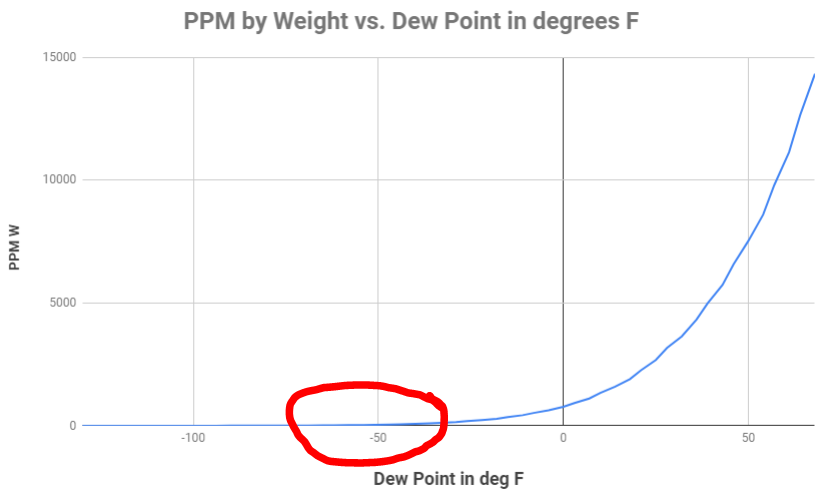
Long term, reliable operation of an ozone system depends largely on clean, dry air. Unless you have liquid oxygen (LOX) as an oxygen source, your ozone will be generated from the oxygen found in ambient air. The air around us contains dust particles, and lots of water vapor. One cubic meter of air on a hot humid day can contain up to 30 grams of water. Even a gram of water vapor in a cubic meter of air (dew point -5 deg. F) will inevitably lead to failure of the ozone generating equipment. We need to get another 9/10 of a gram of water out to keep an ozone generator in good shape.
Water content in air is most commonly measured in terms of dew point. Dew point is the temperature at which water vapor condenses into liquid. When a mass of air cools down to very cold temperatures before water condenses, it indicates that there is not much water vapor in the air. The graph shows that dew point is not linear in relation to the amount of water vapor in the air. It is easy to see that the water content gets close to zero at about -50 degrees F. Large ozone systems operate with feed gas between -100 and -60.
An air filter and desiccant air dryer is often used to clean and dry the air for a small air-fed ozone system. The desiccant material absorbs moisture from the air as it passes through. When the desiccant becomes saturated, air flow is switched to a second chamber of desiccant material while heat is applied to the first to drive the water from the material in the first chamber. The processes switches back and forth, effectively dries the air to a dewpoint of -40 deg F. This is a cost effective level of dryness for small ozone systems.
Ozone systems that use an oxygen concentrator are able to take even more water out of the feed gas. The first line of defense will be the air filter for the air coming into the air compressor used for your ozone system. This filter will remove particles of dust that eventually wear out the compressor as well. The compression process also serves to remove much of the water when the hot compressed air cools forming water droplets that can be removed with a coalescing filter. A compressor with a means to cool the compressed air can bring the dew point from 60 to 40 degrees. This compressed air is forced through the zeolite sieve beds of and oxygen concentrator. The zeolite quickly absorbs the Nitrogen and remaining water vapor. As the oxygen concentrator cycles, the Nitrogen and water vapor is exhausted, leaving 93% oxygen with a dew point from -60 to -100 degrees F. The oxygen concentrator works well as long as water vapor does not build up or condense in the sieve beds. They will not work well when the compressed air has a dew point above 40 degrees or the sieve material absorbs moisture during down time.
Oxidation Technologies provides sales, service, and system design of gas preparation equipment for ozone systems.

I didn’t realize that the content of water in the air is measured by dew points. I’m glad you explained how an air filter and air desiccant dryer works. I’m curious about what kinds of situations in which this would be a useful process or product to have access to.